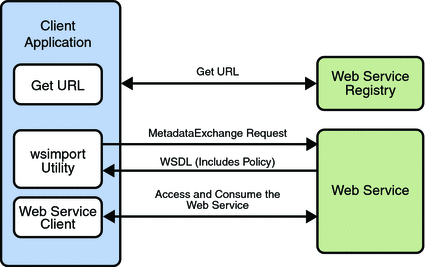Bootstrapping and Configuration
Bootstrapping and configuration consists of using a URL to access a web service, retrieving its WSDL file, and using the WSDL file to create a web service client that can access and consume a web service. The process consists of the following steps, which are shown in Figure 2–2.
Figure 2–2 Bootstrapping and Configuration

-
Client acquires the URL for a web service that it wants to access and consume. How you acquire the URL is outside the scope of this tutorial. For example, you might look up the URL in a Web Services registry.
-
The client uses the URL and the wsimport tool to send a MetadataExchangeRequest to access the web service and retrieve the WSDL file. The WSDL file contains a description of the web service endpoint, including WS-Policy assertions that describe the security and/or reliability capabilities and requirements of the service. The description describes the requirements that must be satisfied to access and consume the web service.
-
The client uses the WSDL file to create the web service client.
-
The web service client accesses and consumes the web service.
Chapter 4, Bootstrapping and Configuration explains how to bootstrap and configure a web service client and a web service endpoint that use the WSIT technologies.
- © 2010, Oracle Corporation and/or its affiliates
